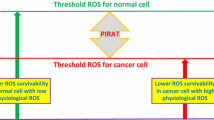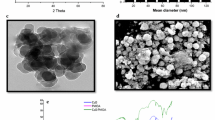Abstract
Further studies on the mechanism of intracellular induction of active oxygen species and selective oncolysis with metal oxide nanoparticles (NPs), as well as the discussion of alternative mechanisms of the NPs impact on tumor cells, are needed to introduce nanotechnologies into antitumor therapy. The paper concerns the inhibition of oxidation processes in tumor cells under the action of manganese oxide-based NPs (size 10–60 nm) as the mechanism of a tumor cell death. When manganese (II) hydroxide-based NPs enter the cells, they are oxidized with oxygen to Mn4+ compounds; the oxidation processes being blocked in the tumor cells. Hence, the MnO NPs cytotoxicity can be due to the possible direct reduction of O2 in the presence of manganese compounds in the cells.




Similar content being viewed by others
References
Akhtar MJ, Alhadlaq HA, Kumar S, Alrokayan SA, Ahamed M (2015) Selective cancer-killing ability of metal-based nanoparticles: implications for cancer therapy. Arch Toxicol 89:895–907. https://doi.org/10.1007/s00204-015-1570-1
Attarilar S, Yang J, Ebrahimi M, Wang Q, Liu J, Tang Y, Yang J (2020) The toxicity phenomenon and the related occurrence in metal and metal oxide nanoparticles. Front Bioeng Biotechnol 8:822
Fu X (2015) Oxidative stress induced by CuO nanoparticles (CuO NPs) to human hepatocarcinoma (HepG2) cells. J Cancer Ther 6:889–895. https://doi.org/10.4236/jct.2015.610097
Tuli HS, Joshi R, Kaur G et al (2022) Metal nanoparticles in cancer: from synthesis and metabolism to cellular interactions. J Nanostruct Chem. https://doi.org/10.1007/s40097-022-00504-2
Xia T, Kovochich M, Liong M, Mädler L, Gilbert B, Shi H, Yeh JI, Zink JI, Nel AE (2008) Comparison of the mechanism of toxicity of zinc oxide and cerium oxide nanoparticles based on dissolution and oxidative stress properties. ACS Nano 2(10):2121–2134. https://doi.org/10.1021/nn800511k
Sukhanova A, Bozrova S, Sokolov P, Berestovoy M, Karaulov A, Nabiev I (2018) Dependence of nanoparticle toxicity on their physical and chemical properties. Nanoscale Res Lett 13:13–44. https://doi.org/10.1186/s11671-018-2457-x
Yang H, Liu C, Yang D, Zhang H, Xi Z (2009) Comparative study of cytotoxicity, oxidative stress and genotoxicity induced by four typical nanomaterials: the role of particle size, shape and composition. J Appl Toxicol 29:69–78. https://doi.org/10.1002/jat.1385
Illarionova NB, Morozova KN, Petrovskii DV, Sharapova MB, Romashchenko AV, Troitskii SY, Kiseleva E, Moshkin YM, Moshkin MP (2020) Trojan-Horse’ stress-granule formation mediated by manganese oxide nanoparticles. Nanotoxicology 14:1432–1444. https://doi.org/10.1080/17435390.2020.1856433
Verity MA (1999) Manganese neurotoxicity: a mechanistic hypothesis. Neurotoxicology 20(2–3):489–97
Gunter TE, Gavin CE, Aschner M, Gunter KK (2006) Speciation of manganese in cells and mitochondria: a search for the proximal cause of manganese neurotoxicity. Neurotoxicology 27(5):765–776. https://doi.org/10.1016/j.neuro.2006.05.002
Gunter KK, Aschner M, Miller LM, Eliseev R, Salter J, Anderson K, Gunter TE (2006) Determining the oxidation states of manganese in NT2 cells and cultured astrocytes. Neurobiol Aging 27(12):1816–1826. https://doi.org/10.1016/j.neurobiolaging.2005.10.003
Razumov IA, Zav’yalov EL, Troitskii SY, Romashchenko AV, Petrovskii DV, Kuper KE, Moshkin MP (2017) Selective cytotoxicity of manganese nanoparticles against human glioblastoma cells. Bull Exp Biol Med 163(4):561–565. https://doi.org/10.1007/s10517-017-3849-0
Razumov IA, Troitskii SY, Solo’veva OI, Boldyrev ND, Zavjalov EL (2020) Manganese oxide nanoparticles inhibit the growth of subcutaneous U-87 MG glioblastoma xenografts in immunodeficient mouse. Cell Techn Biol Med 3:148–153
Kuper KE, Zavjalov EL, Razumov IA, Romaschenko AV, Stupak AS, Troicky SYu, Goldenberg BG, Legkodymov AG, Lemzyakov AA, Moshkin MP (2016) Cytopathic effects of X-ray irradiation and MnO nanoparticles on human glioblastoma (U87). Phys Procedia 84:252–255
Razumov IA, Troitsky SY, Zavjalov EL et al (2020) Synergism of the cytopathic effect of synchrotron radiation and manganese oxide nanoparticles on the growth of human glioblastoma cells in vitro. Nanotechnol Russia 15:819–827. https://doi.org/10.1134/S1995078020060166
Mendham J, Denney RC, Barnes JD, Thomas MJK (1989) Vogel’s textbook of quantitative chemical analysis, 5th edn. Longman House, Burnt Mill
Niks M, Otto M (1990) Towards an optimized MTT assay. J Immunol Methods 130(1):149–151. https://doi.org/10.1016/0022-1759(90)90309-j
Jarosch D (1987) Crystal structure refinement and reflectance measurements of hausmannite, Mn3O4. Mineral Petrol 37:15–23
Oswald HR, Bivalent Asper R, Hydroxides Metal (1977) Preparation and crystal growth of materials with layered structures. In: Lieth RMA (ed) Physics and chemistry of materials with layered structures, vol 1. Springer, Dordrecht. https://doi.org/10.1007/978-94-017-2750-1_3
Cotton FA, Wilkinson G, Murillo CA, Bochmann M (1999) Advanced inorganic chemistry, 6th edn. John Wiley & Sons, Chichester
Place TL, Domann FE, Case AJ (2017) Limitations of oxygen delivery to cells in culture: an underappreciated problem in basic and translational research. Free Radic Biol Med 113:311–322. https://doi.org/10.1016/j.freeradbiomed.2017.10.003
Troitskii SY, Fedotov MA, Kochubei DI, Novgorodov BN, Chuvilin AL, Likholobov VA (2007) Investigation of the formation process of nanosized particles of Ru(III). J Struct Chem 48:144–149. https://doi.org/10.1007/s10947-007-0021-0
Illarionova NB, Petrovski DV, Razumov IA, Zavyalov EL (2019) Effects of radiation and manganese oxide nanoparticles on human glioblastoma cell line U-87 MG glycolysis. Vavilov J Genet Breed 23:81–85
Clément MV, Pervaiz S (2001) Intracellular superoxide and hydrogen peroxide concentrations: a critical balance that determines survival or death. Redox Rep 6:211–214. https://doi.org/10.1179/135100001101536346
Ostrovidov S, Franck P, Capiaumont J, Dousset B, Belleville F (1998) Effects of H2O2 on the growth, secretion, and metabolism of hybridoma cells in culture, in vitro cell. Dev Biol Anim 3:259–264. https://doi.org/10.1007/s11626-998-0132-8
Acknowledgements
HRTEM and SEM studies were conducted under the 0303-2017-0002 AAAA-A17-117041710079-8 (Unit 3) project at the Boreskov Institute of Catalysis.
Funding
The studies were supported by the budget project (No. FWNR-2022-0023) and implemented using the facilities of the Center for Genetic Resources of Laboratory Animals at ICG SB RAS, supported by the Ministry of Education and Science of Russia (RFMEFI62119X0023).
Author information
Authors and Affiliations
Contributions
All authors contributed to the study’s conception and design. Material preparation, data collection, and analysis were performed by Ivan Razumov, Sergei Troitskii, and Olga Solovieva. Evgenii Suprun conducted microscopic studies and analysis of the obtained data. The first draft of the manuscript was written by Ivan Razumov. All authors commented on previous versions of the manuscript. All authors had read and approved the final manuscript.
Corresponding author
Ethics declarations
Conflict of interest
The authors declare no competing interests.
Additional information
Publisher's note
Springer Nature remains neutral with regard to jurisdictional claims in published maps and institutional affiliations.
Rights and permissions
Springer Nature or its licensor (e.g. a society or other partner) holds exclusive rights to this article under a publishing agreement with the author(s) or other rightsholder(s); author self-archiving of the accepted manuscript version of this article is solely governed by the terms of such publishing agreement and applicable law.
About this article
Cite this article
Razumov, I., Troitskii, S., Solovieva, O. et al. Manganese oxide nanoparticles: the influence of manganese oxidation state on selective lysis of tumor cells. J Nanopart Res 25, 140 (2023). https://doi.org/10.1007/s11051-023-05782-7
Received:
Accepted:
Published:
DOI: https://doi.org/10.1007/s11051-023-05782-7




